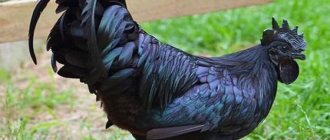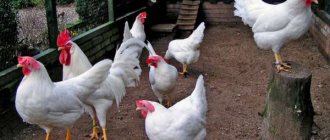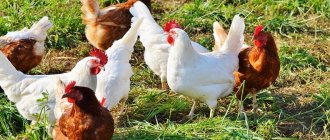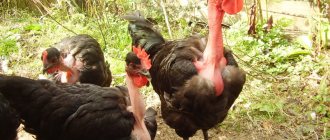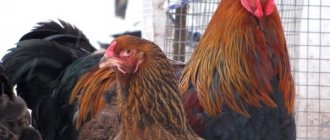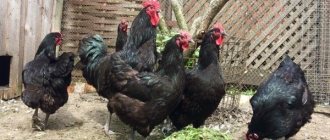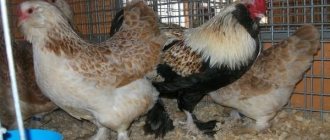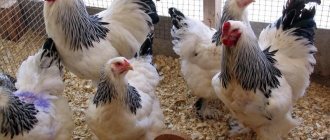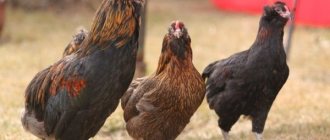Kuchinsky Jubilee is one of the most common breeds of chickens in Russia and dates back to the times of the USSR, when it was bred by state poultry farmers. Kuchinsky poultry plant. She is easy to care for, resistant to diseases, and laying hens have retained their brooding instinct. More details about breeding the Kuchinsky Jubilee are further in the article.
Where are they bred?
The Kuchinskaya breed owes its name to the poultry plant of the same name in the Moscow region. It was there that breeding work was carried out for more than 40 years to create highly productive poultry adapted to the climate of temperate latitudes. In 1990, the standard of the new breed was approved, after which it received official status.
The best representatives were used in the creation of the Kuchin Jubilee:
- Australorps and White Plymouthrocks;
- Rhode Island and New Hampshire;
- Liven breed and Leghorn.
The result fully met the expectations of biologists: they received chickens of the meat and egg line, resistant to cold and easy to keep.
Kuchinka diet
The food for these chickens should consist of:
- feed;
- grains;
- crushed pieces;
- bone meal;
- shell rock (preferably crushed);
- small pebbles;
- boiled fish;
- meat;
- dairy and fermented milk products;
- corn;
- beans;
- peas and other legumes;
- vitamin complex.
Mushrooms in the chicken coop
Any greens are usually added to the mash as vitamins. Birds especially need it in winter and early spring. It’s worth taking care of this in the summer (mowing the grass).
What they look like
Kuchinki are distinguished by red plumage and a black pattern on the chest and neck. Moreover, females and males have external sexual differences.
For laying hens:
- the body is lush, trapezoidal in shape;
- the belly is round;
- the head is small, with a miniature red comb and earrings of the same color;
- the tail is small, with black feathers at the end;
- the beak and legs are ocher in color.
In the rooster:
- the body is large, with a proud posture;
- the body is triangular, with a wide back and a large belly;
- paws and thighs – powerful, strong;
- the tail is black, fluffy;
- the head is set evenly, larger than that of the female;
- the comb is large, leaf-shaped, bright scarlet. The earrings are well defined;
The rooster has a lot of feathers of a rich red-brown color.
Kuchinsky Jubilee has three subspecies, distinguished based on feather pattern:
- Double outlined, each with a black border. The tail is bright, black and red, with a tint. The feathers on the chest are dark, and on the head they are golden, transitioning to charcoal. The predominant feather color of laying hens is red, with a double edge.
- Bordered, each feather of which is painted along with black lines, diverging to the right and left of the shaft, and converging at the end with a rounded black spot. The neck is dark, with a golden-red border. The tail is also dark, with bright yellow splashes on the brown. The belly, wings and chest are bay with gold, while each feather has a black border. The head is light red.
- Speckled. Rare variety. The rooster is black-breasted and red. The chicken's feathers are densely covered with black speckles, especially on the dark brown back and wings. The chest is salmon-brown, the tail pigtails are black.
Kuchinese chickens are born with dark fawn down on their back, with 3 stripes from tail to head. The belly and chest are light. At the same time, roosters have yellow wings, and chickens have dark brown wings.
Distinguishing a male from a female: external characteristics
The description of the Kuchin chicken breed is divided by gender. Males have a medium-sized head, decorated with a comb with 5 erect teeth. The beak of roosters is strongly curved, but small. The eyes are convex and round in shape.
The neck is not massive, but with thick plumage. The back of males is wide, covered with long feathers. The sternum is massive and round. The tail is medium, with curved feathers. The wings fit tightly to the body. The legs of males are strong and muscular.
The description for females is slightly different. Kuchinsky chickens are downed, with thick plumage. The 5-toothed leaf-like comb is straight in the bordered varieties and pendulous in the speckled females.
Character
Kuchinki are active, inquisitive and not shy birds. They are always busy with business, sometimes they like to cluck, but they cannot be called too noisy and impressionable. Within their herd they behave peacefully. Ladies' scandals are extremely rare, because you can't spoil Kuchin males. Roosters are attentive to discipline and order, and can punish. They are strict, but gallant and not cocky, until a potential competitor comes into view.
Chickens of other breeds cannot tolerate hens, so it is better for them to have a separate chicken coop (pen) and their own area for walking.
Productivity
The productive characteristics of chickens of the Kuchin Jubilee breed are as follows:
- egg production is 200-250 pcs. annually. The dense shell comes in different shades of brown - cream to brown;
- egg size is medium. Each weight is about 60 g;
- maturation occurs by 6 months, after which the pullets produce their first clutch;
- If a rooster is present, hens produce up to 95% of eggs suitable for incubation, with a hatchability rate of 85 to 90%.
During molting, egg production decreases, but after it ends it returns to its previous levels.
The live weight of a 2-month-old female is from 1.2 to 1.5 kg. Adult laying hens weigh 2.8-3.0 kg, and roosters 3.7-4 kg. The meat of the kuchinok is light, tender, and has a pleasant taste.
Keeping at home
Kuchints are considered one of the most unpretentious domestic birds, so they can be kept on any farm without much difficulty. In order for the poultry to be healthy and produce high-quality products, the farmer needs to create favorable conditions for it.
Chicken coop
A chicken coop is the number one task for keeping chickens of any breed. This structure makes it possible for birds to protect themselves from cold weather and other unfavorable factors, and creates ideal conditions for a comfortable rest at night. The main requirements for the structure are:
- the room must be of appropriate size (for 1 chicken there is at least 0.2-0.25 square meters of free space);
- the chicken coop has at least 2 opening windows to ensure high-quality ventilation;
- in the building, an optimum temperature is allowed within the range of +21-25°C in summer, and at least +15°C in winter;
- the walls of the chicken coop can be made of wood, brick or concrete, the roof - from any roofing materials (to choose from), the floor - exclusively wooden;
- the floor must have a flooring made of straw, hay or sawdust (flooring thickness - 15-20 cm);
- Additional lighting should be installed in the chicken coop in winter (natural light will be quite enough in summer);
- rooms for raising chickens should have perches and nests.
Read more about chicken leg diseases.
The basic requirements for roosting in a chicken coop are simple:
- the structure should provide one bird with a landing space of 20-25 cm;
- it is made from a wooden beam, the cross-section of which is 4 x 5 cm (the surface is well sanded and the edges are rounded);
- arrange perches on the far side of the chicken coop at different levels at a distance of about 40-50 cm from each other;
- they secure the perch both permanently and with the help of removable connections, providing additional comfort when cleaning the chicken coop.
There are also corresponding requirements for the nest:
- made only from wooden materials;
- the bottom of the structure must be covered with straw (at least 10 cm high);
- secure the nests in 3-4 tiers at a distance of 40-50 cm from each other (the distance from the floor to the first tier is at least 60 cm);
- its dimensions are 35 x 35 x 35 cm;
- one nest is equipped on average for 3-4 laying hens.
To ensure optimal hygiene, the chicken coop and all its contents are periodically cleaned, but at least once a week.
The procedure consists of a rough cleaning, during which large contaminants are removed, and a fine one (which consists of cleaning the chicken coop with a soap solution). Remove droppings and other residues not only from the floor and walls of the room, but also from nests. Once a month, the chicken coop is disinfected by treating with disinfectants (Glutex, Virocide or interchangeable analogues). Important! Before cleaning the chicken coop, the bird should be moved to a temporary building or to a walking yard. This will not only simplify the procedure, but also protect the chickens from possible injury or harm from cleaning products.
Walking yard
The walking yard is especially important for Kuchinsky jubilees. With its help, the bird compensates for the deficit in motor activity, thanks to which it manages to keep its body in optimal tone. Free walks help activate metabolism, which has a positive effect on overall health and immunity. In addition, a walking yard is also important for meat products. Optimal physical activity helps birds develop muscles, which means the quality of meat, its aromatic and taste properties increase.
The most optimal place for a walking yard is considered to be a flat, dry area near tall tree-like vegetation. Shade on the site is considered one of the most dominant factors, since excessive sun is extremely harmful for chickens. If there is not enough natural shade near the chicken coop, use a canopy made of fabric or other roofing materials.
A fence made of plastic or metal mesh 2-2.3 m high is installed along the perimeter of the courtyard. Any sharp elements inside the structure are unacceptable, as the bird may be injured. It is not recommended to save on walking yard space. The walking area must provide at least 1 sq.m/individual of free space.
Feeders, drinkers, zone baths
Chickens need an uninterrupted supply of food for optimal performance. The feeder should be a low elongated shape with a depth and width of at least 10 cm. The length of such containers depends on the number of birds in the population. The best option is considered to be feeders, where each individual has at least 10 cm of its length. Feeders are made from hardwood (metal is also possible).
They must be resistant to any food and not release harmful toxins during their operation. A few decades ago, shallow open containers or old feeders served as drinking bowls for chickens, but today many have abandoned them in favor of factory models. Their design does not allow the bird to splash water, which significantly reduces daily labor costs for care. They are selected based on the number of birds in the population.
So, one drinking bowl should hold no more than 5 liters of water, otherwise it will lead to rapid contamination, and this is fraught with poisoning. Drinkers are placed near the feeders both in the poultry house itself and in the walking yard. A prerequisite for a poultry farm is the presence of a zone bath. It is needed not only for the entertainment of the bird. Chickens quite often suffer from a variety of parasites, and a zone bath helps them cleanse their bodies of lice and mites.
Find out how to make and install nipple drinkers with your own hands.
Install a bath in the walking yard, on the opposite side of the feeder and drinking bowl. Any non-toxic and non-traumatic container can serve as a zone bath. It is often made from dry, carefully sanded wood. The optimal dimensions of the bathtub are 120 x 70 x 20 cm. Such a box can accommodate 3-4 individuals at the same time. The number of baths depends on the size of the flock (in most cases, no more than one bath is installed for 10 chickens).
Beginning of molting and break in egg production
Plumage change is a natural physiological process inherent in both productive and ornamental bird breeds. In young chickens, molting occurs in three stages:
- at the age of 1-1.5 months - chickens acquire downy plumage, which replaces down;
- at the 3rd month of life - the young animals lose their down feathers and outline feathers appear;
- in early or mid-spring - exclusively in chickens under 1 year of age.
Important! Slow and prolonged molting indicates a low productive potential of chickens, so after molting such individuals are transferred to a separate herd (for slaughter).
In adult chickens, this process begins at a time when daylight hours decrease sharply. This period often falls in mid-autumn. Molting is accompanied by a sharp decrease in egg production or a complete loss of the ability to lay eggs. For the Kuchin Jubilee breed, it lasts 2-3 weeks, but in some cases it can last up to 4-5 weeks.
During molting, the hormonal levels of Kuchin cats change dramatically, which is a serious stress for the body. Therefore, the bird needs special care and additional attention. At this time, the poultry farmer is obliged to:
- provide enhanced nutrition with the addition of complex supplements based on vitamins A, B1, B3, D and microelements in the form of iodine, manganese and sulfur;
- improve the sanitary situation in the chicken coop;
- eliminate drafts and sudden temperature changes in the area where the poultry is kept;
- install artificial lighting in the poultry house and provide the chickens with at least 10 hours of daylight;
- provide the wards with complete peace and quiet;
- Avoid tactile contact with the livestock, as during molting this causes unpleasant sensations in them.
Planned herd replacement
The productivity of Kuchinsky Jubilees lasts up to 3 years, after which their egg production practically stops. The highest productivity of the breed is observed only in the first 1-1.5 years, so a planned replacement of the herd should be carried out at least once every two years. For greater profitability, many large farms recommend rejuvenating the livestock annually.
After the peak of egg production, you can successfully send part of the herd to slaughter and profitably sell meat products. Otherwise (at the age of 2 or more years), the chicken becomes old and loses its aromatic and taste qualities.
Check out such meat and egg breeds of chickens as: Zagorsk Salmon, Maran, Dominant, Australorp, Amrox, Welsumer and Lakenfelder.
How to keep
It is better to keep Kuchin Jubilee chickens on the floor, because they are cramped in cages. When arranging a barn or a walking yard, it is important to consider that:
- the birds are in good health, so they are resistant to frost, but they do not lay eggs well in a cold barn. To maintain positive temperatures, the floor is insulated for the winter with a thick bedding of sawdust and dry straw;
- Since the individuals are large and heavy, they fly poorly. This means that it is better to make the perches wide, at a height of up to 1 m from the floor, and the yard does not have to be covered with a net;
- In the barn, as well as on the street, it is necessary to place containers with ash and sand. The chickens will “bathe”, periodically clearing themselves of lice eaters.
It is important to maintain poultry house hygiene. Birds living in a dirty barn get sick, slowly gain weight, and do not lay eggs well.
Chicken care
The Kuchinsky breed of chickens is unpretentious in keeping, but it does not like cages. It is recommended to keep birds in chicken coops using the floor method. A deep bedding is prepared for them, at least 7 cm. Peat is used as bedding. The area of the chicken coop must correspond to the number of livestock. No more than 4 chickens are placed per 1 m2. The temperature is maintained at 14 C, humidity 60%. The optimal daylight hours are 12 hours.
The following diet is prescribed for laying hens:
| № | Helpful information |
| 1 | cereal mixture 60 g |
| 2 | legumes – 6 g |
| 3 | protein supplements, cake, yeast, pulp – 8 g |
| 4 | animal flour, including fish flour – 6 g |
| 5 | green grass in summer or boiled potatoes in winter – 20 g |
| 6 | pine flour – 10 g |
| 7 | shell – 4 g |
| 8 | salt 1 g |
| 9 | pebbles with a diameter of 4 mm – 1 g |
Feeders for chickens of the Kuchin breed are installed on the floor or mounted on the wall, to a height of no more than 20 cm. Drinkers are made vacuum. Birds need perches. They are installed at a distance of 50 cm from the floor. Nests must be equipped in the chicken coop. They should be comfortable for laying hens. For nests, choose the far corners of the chicken coop.
Kuchinsky chickens are well suited for breeding in private backyards and for the development of farms. They don't cause much trouble. The beautiful color of the plumage looks good on green lawns. In the summer, the livestock is kept in spacious enclosures. A site is chosen with good vegetation. Wheat sprouts and clover are preferred. It would be good if there were dandelions, chamomile, and alfalfa in the meadow.
What to feed
Kuchinkas require diets typical for meat and egg chickens. Wherein:
- During the cold season, feeders should be filled three times a day. In summer, daytime feeding can be skipped, since birds on the range consume enough worms and green grass;
- It is important to control the amount of food consumed. Kuchin chickens are famous for their excellent appetite, but are prone to overeating. Obese females lay eggs worse, and in order for them to lose weight, food high in proteins and carbohydrates is partially replaced with vegetables and herbs;
- The egg shells will be strong if you give the quons mineral supplements in the form of chalk and crushed shells.
In addition to the main component of nutrition - grain, chickens should receive:
- meat and bone and fish meal;
- cottage cheese and whey;
- meat and fish trimmings, boneless;
- carrots, cabbage, zucchini and other vegetables, as well as tops.
Due to the consumption of large volumes of dry food, birds drink a lot. Drinkers with fresh water should always be freely available.
Features of feeding
Kuchin chicken is very voracious. To prevent the bird from becoming fat and laying eggs well, it must be limited in food. In the summer, the share of succulent green food reaches 60% of the total diet.
The grain consumption per chicken per day is 100-120 grams. In winter, the amount of feed is increased. The birds are given wet mash, mixed feed, sunflower cake, and vegetables.
Additionally, laying hens need calcium. Chalk, bone meal, and eggshells are added to the main food.
If the heaps become fat, high-carbohydrate foods are removed from the diet - potatoes, potato peelings.
How to breed
The Kuchin Jubilee breed reproduces well within itself. Females are excellent brood hens, so breeding is not difficult. To obtain fertilized eggs, one rooster is enough for 13-15 laying hens. For laying, females choose the darkest and quietest corners of the chicken coop. Nest boxes, measuring 0.4 m x 0.4 m and a side height of 0.25 m, should be placed there. One is enough for 6 quotes.
Each hen is able to “take custody” of up to 15 eggs at a time. Due to their developed instinct, Kuchin laying hens quickly lay eggs; therefore, when receiving chicks is not part of the poultry farmer’s plans, the nests should be checked daily and the eggs should be removed in a timely manner.
A selfless hen can sit for days, forgetting about food and drink. If you do not notice this in time, the bird will weaken and will not be able to complete the job. To prevent this from happening, it is necessary to place the feeder and drinker closer to the nest. Particularly fanatical individuals are carefully removed from the clutch and taken to bowls. This should be done carefully so as not to scare the “mother”.
If the incubation material was selected correctly, after 3 weeks each egg will hatch into a healthy and active chick.
Breeding chickens
About half of the laying hen population, starting at six months of age, begins to hatch eggs. Each Kucha breed can hatch and raise 13-15 chickens without any problems, but you can try laying up to 27 eggs.
If you forget about the bird during the laying period, it may die from hunger or dehydration due to its strong instinct to hatch. The poultry farmer must remember this and remove it from the clutch to feed it at least once a day.
Smart, active chicks are born practically without any physiological abnormalities.
Hatchery chicks may experience the following problems:
- the embryo may freeze in the egg and not hatch;
- the chicken may hatch with the umbilical cord wrapped around its foot, which does not allow it to absorb the remaining yolk and deprives it of strength for further growth;
- farmers notice pecking of incubator eggs, which leads to the death of the embryo.
The hen raises 100% of the chicks, while about 5-15% die in the incubator.
Material selection and incubation
Egg selection occurs according to the following parameters:
- eggs are carefully selected - correct shape, medium size, without cracks or growths;
- carefully clean them, but do not wash them (if you wash off the shell film, the eggs will be unsuitable for incubation or incubation);
- store eggs in a cool place and in clean containers;
- Incubation material can be collected for no more than 2 weeks.
More information about laying eggs in the incubator, as well as their care during this period, can be found here.
The organization of hatching involves the following steps:
- The nest is located in a cool, secluded place, away from other nests.
- The size of the nest should be 40x40 cm, cover it with straw or hay.
- Place the eggs in the nest in one row in a horizontal position.
- The eggs are turned over to prevent the embryo from sticking every 2-3 days.
- After a week, the eggs are checked for the presence of an embryo; if not, they are removed.
- The hen is fed every day mainly with dry food, and is also provided with free access to water.
Hatchery hatching involves the following sequence:
- The device is disinfected and turned on a day before laying the eggs.
- The eggs are brought into a room where an incubator is installed to gradually warm them to room temperature.
- The eggs are placed in the incubator, the temperature is set to 37.9 °C, and the humidity is 66%.
- The eggs are turned 4 times a day until the 12th day.
- From the 13th day, reduce the temperature to 37.3 °C, humidity to 53%.
- Coups are carried out in the same number. The incubator is ventilated 2 times for 5 minutes.
- From the 18th day, humidity is reduced to 47%.
- Turn the eggs 4 times, air them 2 times for 20 minutes.
- 20-21 days - reduce the temperature to 37 ° C, raise the humidity to 66%, stop turning the eggs, ventilate for 5 minutes twice.
- After 21 days, the chicks are born; the process takes several hours.
After birth
The following steps should be taken when hatching chicks:
- the chickens are transferred to a warm place (box), where the temperature is maintained at 25-28 °C at the edges, 34 °C under the lamp;
The location of the chicks should be heated unevenly. Each chick should be able to independently choose a place with the optimal temperature for it.
- after the appearance of the first plumage, the temperature is reduced by 3 degrees every week;
- at the end of the first month, the temperature of the chickens is reduced to 20 °C.
The care and heating of naturally bred chicks is taken over by the black-billed bird.
At the age of 5-6 days, chickens are released for walking in warm weather. At first the time should be 5 minutes and gradually increase. To do this, it is better to equip a special enclosure for young animals.
Diet
From the first days of life, chickens are offered chopped boiled eggs with semolina at the rate of 1 egg per 25 chickens.
Next enter:
- vegetables (boiled potatoes, carrots);
- greenery;
- cottage cheese;
- additives (bone meal, fish, coal, chalk, coarse sand).
From 2-3 weeks, chickens are introduced to grains and cereals. At first they are ground.
After a month, the chickens can be kept together with adults.
Kuchinsky Jubilee chickens grow much faster than other breeds.
How to select eggs for incubation
There are rules for choosing eggs that allow you to get a high-quality brood:
- The incubation material should be of medium size, have a regular - not round or elongated - shape, without calcareous growths and signs of damage to the shell.
- Choose clean eggs. Single traces of droppings can be removed manually, but not washed off - after contact with water, a thin film covering the shell is removed. Without it, the egg is not suitable for both natural and artificial incubation.
- After a few days of incubation, the material is checked with an ovoscope. Eggs without an embryo are immediately discarded.
The selected material is stored for no more than 10 days in a dark and cool place, but not in the refrigerator.
What do chickens get sick with?
It was mentioned above that representatives of the Kuchin Jubilee breed have good health, but if they are not properly cared for and fed, these birds can also get sick. Most likely:
- Vitamin deficiency is a pathology caused by a deficiency of vitamins. By focusing on protein feed, would-be poultry farmers forget about the importance of vitamin supplements, especially in the cold season. As a result, chickens:
- lose appetite;
- grow worse;
- mature later;
- suffer from digestive disorders;
- they rush weakly.
Vitamin premixes mixed into the feed will help quickly solve the problem.
- Gastroenteritis is inflammation of the mucous membrane of the stomach and intestines. Its cause can be either a blockage of the crop due to overeating and lack of water, or an infectious lesion associated with the consumption of stale (contaminated) food. Among the symptoms:
- refusal to eat;
- hyperthermia;
- green intestinal stool, liquid consistency.
A sick bird should be removed and shown to a veterinarian, because Treatment of infectious gastroenteritis requires the use of special drugs. It is also mandatory to replace unsuitable feed with quality feed.
- Cannibalism is a pathology in which chickens behave aggressively, pecking each other for blood. There can be many reasons for such a violation. One of them is protein deficiency. To solve the problem, it is important to understand the reasons.
Cannabalism due to lack of protein food, for example, can be eliminated by changing the diet. In this case, the affected birds should be removed from the flock so that their relatives do not peck to death.
Which is better - an incubator or a brood hen?
Having decided to try yourself as a poultry farmer, you need to know the rules and features of raising chickens at home for beginners. First of all, you need to decide how the chickens will be raised:
- with the help of a hen
- using an incubator
This issue needs to be looked into in more detail. The fact is that many experienced poultry farmers prefer to use an incubator for breeding poultry. We'll figure out why a little later. But for those who are new to this business, you can try to start raising chickens naturally - by placing a chicken egg under the hen.
You can identify the hen among other individuals by her behavioral characteristics - she spends a long time in the nest, resists and makes bubbling sounds when they try to take her from the nest. And even after parting with her favorite place, she tries to return there as quickly as possible.
You can place from 11 to 21 eggs under one hen. The exact amount depends on its size and weight. The average duration of the incubation period is usually 22–23 days. All this time, the hen needs to be fed and watered twice a day, even if she does not show any interest in food or water. Otherwise, exhaustion and death may follow. A separate cage may be required for this period.
It is recommended to keep the earliest hatched chickens in separate cages or boxes, the floor of which is covered with warm bedding, and a lamp is installed at the top.
When the last chicks are born, they can be placed in the same room with the chicken and the rest of the young.
Despite the fact that this method of breeding poultry is natural, it has some disadvantages:
- The process is lengthy and can be carried out, as a rule, once a year (in warm weather).
- Low hatchability.
- There is a high probability of damage and pecking of eggs by the hen.
But I would also like to note the positive aspects:
- Minimum financial costs.
- Finding the hatched chicks with the hen.
- High survival rate of chicks.
Advantages and disadvantages
The advantages of kuchinki are:
- features of feather color, thanks to which the shaft remains light, and the processed carcass has an excellent presentation;
- external sexual differences that make it possible to distinguish laying hens from roosters from the first days of life;
- strong immunity and a thick layer of warm fluff, making birds resistant to cold;
- unpretentiousness to feed;
- stress resistance;
- the ability to quickly get used to the owner and a new habitat;
- precocity;
- excellent productivity;
- high dietary characteristics of meat and eggs;
A separate advantage is the autosex nature of the breed, as well as the pronounced maternal instinct in laying hens. All this makes breeding Kuchin Jubilee chickens simple and low-cost.
The disadvantages include:
- tendency to gain excess weight;
- impossibility of keeping in the same territory with representatives of other breeds.
Against the background of the “advantages” of hens, their “disadvantages” are insignificant, because obesity can be prevented by balanced feeding, and the problem of conflicts in the chicken coop and yard can be solved by partitions.
Temperament of Kuchin chickens
Birds of this breed are active, inquisitive, with a pronounced territorial instinct. They find it difficult to tolerate being kept in closed, confined spaces.
The breed is talkative: a large number of chickens makes a lot of noise.
Females of this breed are peaceful; females can compete with each other and show aggression when kept in close quarters.
The ratio of hens and roosters is set at the rate of 13-15 females per 1 male; a larger number of hens increases the nervousness of the livestock - then some of the birds are resettled to another male.
Chickens quickly adapt to a new place and new living conditions.
